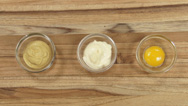Cook's Illustrated: Potatoes
- Posted 10.25.12
- NOVA scienceNOW
Different potatoes contain different amounts of starch, which is why certain spuds are better to use in soups and salads, while others are best used for baking. Find out which potato you should choose for your next meal.
Transcript
Cook's Illustrated: Potatoes
Posted: October 25, 2012
Cook's Illustrated
The Science of Good Cooking
Concept 25: All Potatoes Are Not Created Equal
Dan Souza (Associate Editor, Cook's Illustrated): You might think that one potato is pretty much the same as the next, save for slight differences in skin color, shape or size, but in reality a russet and a red bliss are not created equal.
Now, all potatoes consist mainly of two things: starch and moisture. The ratio of starch to moisture determines the potato's density. More starch, it's more dense. More water, it's less dense.
Now, knowing the overall density of a particular potato is important, because it helps determine what the final cooked texture of that potato will be. Now, there's an easy experiment that you can do right at home to find out the density of any particular potato. And I'll show you.
In each of these three containers I have an 11 percent salt solution. That's 11 percent salt to water, by weight. I'm placing one variety of potato in each. As you can see the red bliss potatoes float, the Yukon golds are suspended right in the middle, and the russets sink to the bottom. Red bliss potatoes contain far less starch (and thus more moisture) than russets so they float, where as high starch russets sink. Yukon Golds have a starch content between these two varieties and they sit right in the middle.
Now, the second important factor to consider is the ratio of two starches, amylose and amylopectin. Russets not only contain more overall starch, but a higher ratio of amylose, whose long chains separate when exposed to heat. This separation allows for more absorption of moisture. That can be in the form of butter or cream, which is why we use russets most often when we're making mashed potatoes.
On the other hand, red bliss contain a higher ratio of amylopectin, whose branched structure holds together when exposed to heat. Less moisture is sucked into a red bliss potato as it's cooked, and more of its original shape is preserved. These characteristics make red bliss potatoes ideal for soups and salads.
Now, we can actually see the difference in these starches by cooking cubes of each variety of potato in water that we've dyed with blue food coloring. We cooked the potatoes, let them cool, and cut them in half as you can see here.
Now, russets' greater amount of overall starch, and higher ratio of amylose, mean that it absorbs a lot of the blue food coloring during cooking. As you can see it travels almost to the middle. In contrast, the red bliss have just a fine line of blue on the outside. They're white all the way through. Once again, Yukon Golds sit right in the middle.
So, now that you know the difference in the densities and starch composition of each variety of potato, you can choose the right spud for every dish.
Credits
Production Credits
- Video short produced, photographed, and edited by
- Nick Dakoulas
- Test Kitchen Experiment Editor
- Dan Souza
- Project Editor
- Molly Birnbaum
- Science Editor
- Guy Crosby, Ph.D.
- Editorial Director
- Jack Bishop
- Original Footage and Illustrations
- © America's Test Kitchen 2012
Image
- (potatoes)
- © America's Test Kitchen 2012
Related Links
-

Can I Eat That?
Learn about the neuroscience of taste, why we cook our food, what makes a Thanksgiving turkey savory, and more.
-

Cook's Illustrated: Sauces
The secret to the perfect vinaigrette is in the emulsifier.
-

Food Science: Expert Q&A
Michael Brenner, who teaches a class on the science of cooking, talks about egg whites, ethylene, protein, and more.



